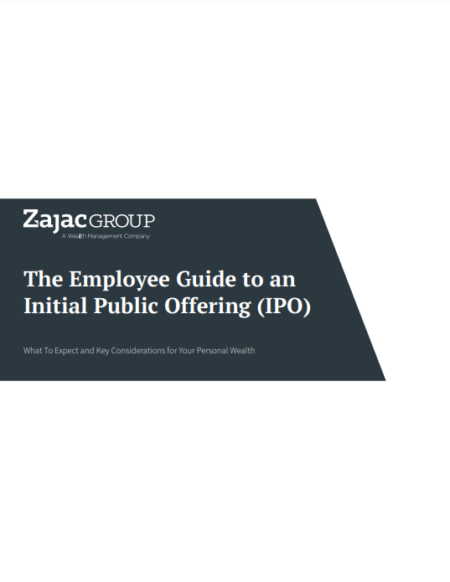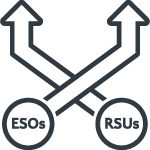Being part of an initial public offering, or IPO, is an exciting time. This is when a private company goes through the process of getting listed on a publicly-traded exchange. Where shareholders may have previously only been able to buy or sell the company’s equity in private deals (if allowed by the company), an IPO allows for company stock to be bought, sold, or traded publicly.
If you hold stock or other equity compensation, an IPO means a liquidity event where you can possibly cash in on the shares you hold – often at a price that’s higher than the previous value of your equity.
It’s reasonable to feel excited when your company IPOs, as it’s an opportunity for you to capture some of the growth in your stock. That’s all the more reason it’s also important to keep a level head and consider what happens once your shares become publicly traded.
On paper, your company IPO may increase your wealth significantly. But you have a lot to consider between now and when you turn those paper gains into real profit.
Understanding the Leadup to When Your Company IPOs
As your company approaches an IPO, you’ll likely begin to hear rumblings or see news of an S-1.
An S-1 is a document your company must file with the SEC in order to be listed on a national exchange and includes information such as financials, business model, use of the proceeds, and other key data points. Investors can use the information provided in the S-1 to determine whether or not they want to invest in the company.
Free Guide to IPOs
If you’re an executive, director, or other critical employee whose company is in the throes of an initial public offering (IPO), you’ll want to read this.
Download Now
As part of the IPO process, you’ll also likely hear about a price range for company stock. For example, you might hear people inside or outside the business say things like, “We expect the IPO to be priced between $18-$20 per share.” While this isn’t definitive, it should give you some indication of the value of your stock compensation.
But there are a few things you want to keep in mind in all the excitement when your company might go through an IPO.
First, filing an S-1 does not guarantee that your company stock will go through with its initial public offering. Registration can be pulled, and the IPO be delayed or never occur.
It’s also possible for the expected price range to change as the demand for the shares rises or falls. The only way to truly know for sure what your shares are worth is to see what happens on the day of the IPO itself.
You Should Prepare for Stock Price Volatility When Your Company IPOs
As your company goes from private to public and you first see an expected IPO price, it’s easy to attach to that particular number as the definitive value for the company’s shares. But it’s important to avoid believing this single price point is an end-all, be-all figure.
The IPO price is simply the price at which the underwriters (the team helping your company go public) sell shares of stock to investors. After that allocation of stock, the stock price will move with the public market and can be volatile. It’s not unusual to see significant swings in price, potentially up and down.
Volatility in the price of the stock may be enough to drive you up a wall if you track its every move, as you see the value of your portfolio increase and decrease dramatically during a time when you might not be able to sell your shares (but more on that particular issue in a moment).
Following the IPO, you should prepare for meaningful changes in stock price, which means meaningful changes in the value of your net worth. Don’t let the volatility surprise you.
Why You May Want to Liquidate Some (or All) of Your Stock When Your Company IPOs
For many reasons, selling some of your equity when your company IPOs may be something to consider. It may be the first time to cash in on years of hard work. Or it may simply make sense as a way to reduce the stock price volatility that comes with a concentrated position in a single stock.
Managing your concentration risk is extremely important for all investors, and employees with equity compensation who just went through an IPO may need to be particularly aware.
In general, most financial advisors will suggest keeping no more than 10 to 15 percent of your investment portfolio in any concentrated position – whether it’s your company stock or another asset. This is to protect you from volatility and lack of diversification.
With equity compensation, it may not be practical (or possible) to get rid of all your shares, all at once, to keep yourself at that 10 to 15 percent guideline. In that case, you need a strategy to liquidate some shares over time and in a tax-efficient way. This is especially true if you’re risk-averse, you need to generate cash to fund other goals, or you need to take action as part of a broader tax strategy.
Whatever the reason, an IPO presents a great time to consider your overall financial strategy, and how company shares in your investment portfolio may impact that big-picture plan.
Know If You’re Subject to a Lockup Period When Your Company IPOs
Many companies that IPO stipulate that employees with equity compensation are subject to a lockup period after the IPO event (sometimes 180 days). This means that even though you own shares of a publicly-traded stock and can readily see the value of the shares, you will not be able to sell your shares immediately.
The lockup period clause is often part of the agreement that your company makes with the underwriters of the initial public offering. Your grant agreement should detail the rules and obligations you may need to follow in regards to a post-IPO lockup, so be sure to review that carefully.
While the traditional IPO generally includes a post-IPO lock up period, it’s possible that your company IPO or direct listing may allow you to sell some or all your shares immediately. (This is another good reason to double-check your grant agreement.)
Some companies will allow shareholders to participate in an early lockup release or other events that allows for the sale of some portion of your vested stock during the release period. For example, they may say you can sell X% of your vested shares during the first X days following the IPO.
As the early lockup release period ends, a traditional lockup could begin. Additional methods for determining your ability to sell in and around a lock up period may also be available to you. You should check with your company to see what the specific details for your ability to sell may be.
A direct listing is another example of a time that you can sell shares immediately upon being listed. A direct listing allows a company to go public without the use of an underwriter. With no underwriter involved, no post-IPO lockup is necessary.
You May Be Prevented From Selling During a Blackout Period, Too
In addition to the post IPO lock-up restrictions, you may also have to plan your sale of stock around blackout periods. A blackout period is a period of time, often before annual or quarterly earnings releases, when insiders are prohibited from selling their shares of stock.
If your company identifies you as an insider, that could limit your ability to sell shares during this particular blackout period.
For example, let’s assume that your company has an “open trading window” of 30 days. This is a designated period of time after the blackout period (which could last something like 61 days) where you are allowed to sell shares following earnings statements.
In this example, your open window may look like this:
| Length of Period | Can I Sell Shares | Hypothetical Month | |
| Open Window | 30 days | Yes | Jan |
| Blackout Period | 61 days | No | Feb – Mar |
| Open Window | 30 days | Yes | Apr |
| Blackout Period | 61 days | No | May – June |
| Open Window | 30 days | Yes | July |
| Blackout Period | 61 days | No | Aug – Sept |
| Open Window | 30 days | Yes | Oct |
| Blackout Period | 61 days | No | Nov – Dec |
*Length of period and time of each month is approximated for illustrative purposes
Open trading windows and blackout periods tend to be cyclical over a 90-day period. Following this cadence, you may only have a total of 4 months out of the year to sell your shares, or 1 month for each quarter.
When Your Company IPOs, You Need a Plan for Cash Flow, Taxes, and Your Overall Portfolio
Once you do exercise your stock options or sell your shares post-IPO, you’ll want to have a plan in place to manage the cash flows associated with the sale.
For some types of equity compensation, including restricted stock units, stock appreciation rights, and non-qualified stock options, some of the tax obligations may be covered for you via a share withholding or a sell-to-cover.
However, even when withholding happens automatically, it’s still smart to run your own tax projections to confirm you’ve set aside enough money to cover all taxable events. The amount withheld from sales may not be enough to cover the full amount of taxes you’ll eventually owe when you file your return.
For other types of equity, such as incentive stock options, the tax implication can be more complicated. This is thanks to the alternative minimum tax and required holding periods that designate the tax rate that will apply to any gains.
As you sell your stock after an IPO, good tax planning is crucial so you can understand how much you will receive after-tax. Once you figure this amount, you can begin to plan for how you’ll put your proceeds to good use within the context of your financial plan.
If you don’t have a financial strategy in place, now is the time to consider working on this. Doing your financial planning before your company goes through an IPO will better position you to take full advantage of this big opportunity.










0 Comments